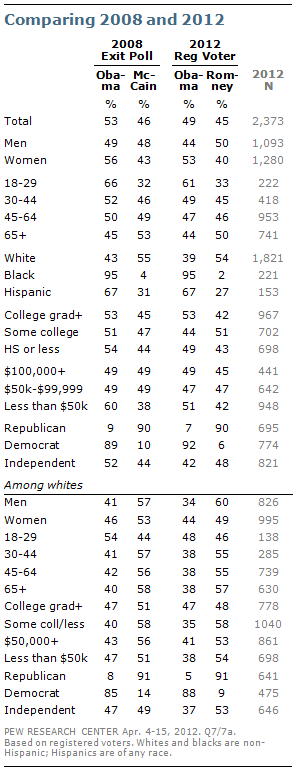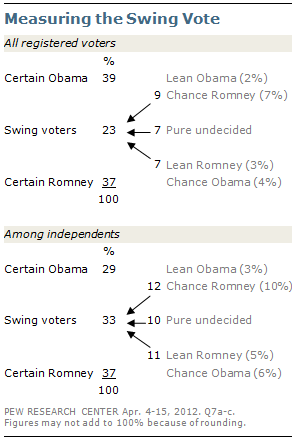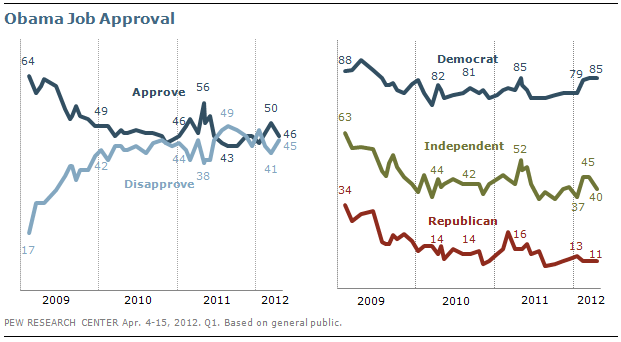
As the general election campaign gets underway, Obama’s slim 49% to 45% edge over Mitt Romney is based on his continued support among women, college graduates, blacks, Latinos and lower-income voters. Obama leads Romney by 13 points among women, which is identical to his victory margin over McCain among women four years ago, according to National Election Pool exit polls. Men, who split their vote between Obama (49%) and McCain (48%), are leaning slightly toward Romney today, by a 50% to 44% margin.
Young voters backed Obama over McCain by a 66% to 32% margin in 2008, and continue to support him over Romney by 61% to 33%. However, whites under 30 are now divided (48% Obama, 46% Romney). In 2008, they supported Obama over McCain by 10 points, (54% to 44%).
Fully 95% of blacks back Obama for reelection – identical to the black vote for Obama in 2008. Hispanic registered voters back Obama by a 67% to 27% margin. The Hispanic vote was 67% Obama, 31% McCain four years ago. These figures also are consistent with a Pew Hispanic Center survey of 557 Latino registered voters in December, in which 68% backed Obama and 23% Romney despite widespread dissatisfaction with Obama’s immigration policies. (For more see “As Deportations Rise to Record Levels, Most Latinos Oppose Obama’s Policy,” Dec. 28, 2011.)
Obama has lost support among several groups: Obama carried the independent vote by a margin of 52% to 44% in 2008. Today, 42% of independents favor him, while 48% back Romney. Obama also is faring worse among lower-income voters and those with less education than he did in 2008.
Obama trails Romney by a wide margin among white voters (54% Romney, 39% Obama), though that is little changed from 2008. But Obama has lost ground among certain groups of white voters. In 2008, whites with household incomes under $50,000 favored McCain over Obama by a slim 51% to 47% margin. Today, lower-income whites favor Romney over Obama by a 16-point margin (54% to 38%).
By contrast, Obama is running about the same as he did in 2008 among whites with higher incomes and college degrees. He trails Romney by 12 points among whites with family incomes of $50,000 or more and runs about even among white college graduates.
There is a greater gap between white men and white women today, not because white women have moved toward Obama, but because white men have moved away from him. White men gave McCain a 16-point edge four years ago (57% McCain vs. 41% Obama). This has widened to a 26-point lead for Romney today, 60% to 34%.
White independent voters, who favored McCain slightly in 2008 (49% McCain vs. 47% Obama), are leaning more Republican this year. About half of white independent voters (53%) support Romney, while just 37% favor Obama; 10% are undecided.

2012 Campaign Dynamics
Obama’s lead over Romney has narrowed since last month, when he had a 12-point advantage, though it is comparable to margins from earlier this year. While Obama’s advantage has declined since March, there is little to suggest a specific problem or campaign event as having a critical effect.
While there have been debates over issues related to gender, the rise and fall in Obama’s support has largely crossed gender lines, with a fairly consistent gender gap over time. For example, since March, Obama’s support among both men and women has slipped five percentage points.
Independent voters remain up for grabs. In the current survey, 48% favor Romney while 42% back Obama. A month ago, it was 47% Obama, 44% Romney.
Swing Voters
With more than six months to go until the election, many independents have yet to commit to either Obama or Romney. While 90% of independents express a preference, only 66% say they are certain about how they will vote.

More specifically, of the 48% of independents who favor Romney, some say they only lean toward him (5%) or say there is still a chance they might vote for Obama this year (6%). Similarly, of the 42% who favor Obama, some either just lean toward him (3%) or say there is still a chance they might vote for Romney (10%). Added together with the 10% of independents who have no preference between the two, fully a third (33%) of independents are still uncommitted or “swing” voters.
This is a significantly smaller swing vote than was the case at the end of the primary season four years ago. In June 2008, 33% of all registered voters, and fully 46% of independent voters, remained uncommitted. Today, just 23% of voters, and 33% of independent voters, are swing voters.
This is not uncommon when an incumbent is up for reelection and voters feel they have a clearer sense of the options before them. In June 2004, just 21% of registered voters were swing voters, including only 28% of independents.
Obama Approval Little Changed
Currently, 46% approve of the way Obama is handling his job as president while about as many (45%) disapprove. In March, 50% approved of Obama’s job performance; 41% disapproved. In February, 47% approved and 43% disapproved.
Obama continues to draw overwhelming support from Democrats (85% approve). Just 11% of Republicans approve of the way he is handling his job as president, while 85% disapprove. More independents disapprove (50%) than approve (40%) of Obama’s job performance. That represents a change from March and February, when Obama’s job rating among independents was almost evenly divided. In March, 45% of independents approved of Obama’s job performance, while 42% disapproved.
